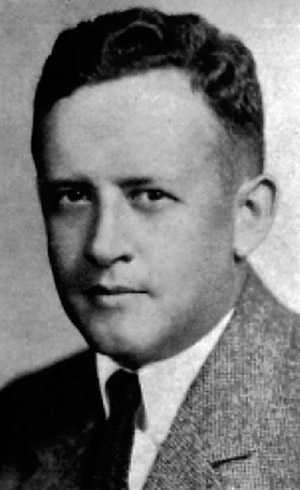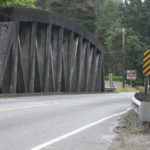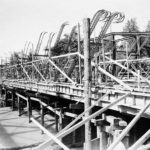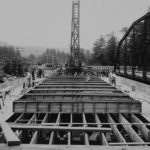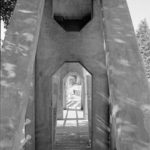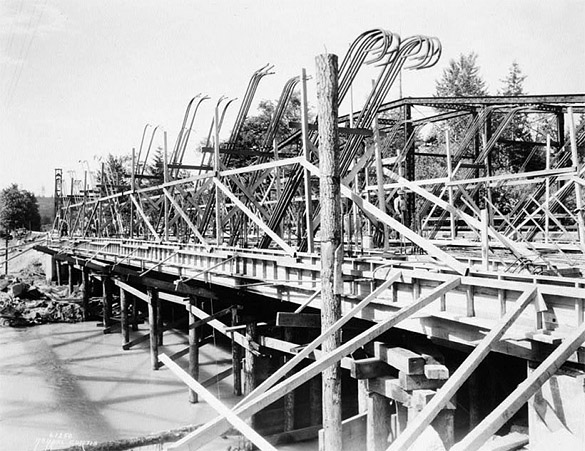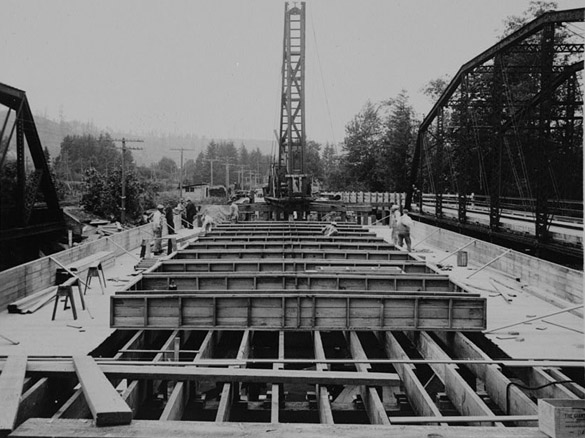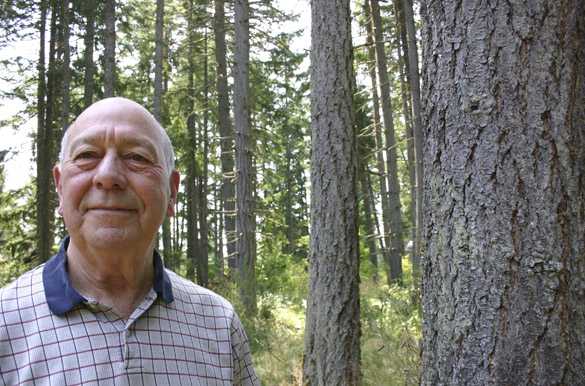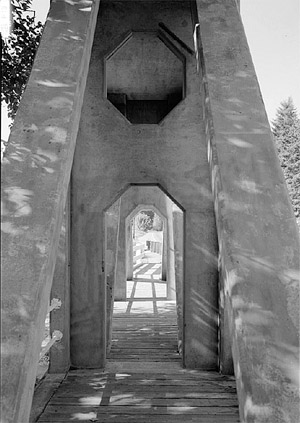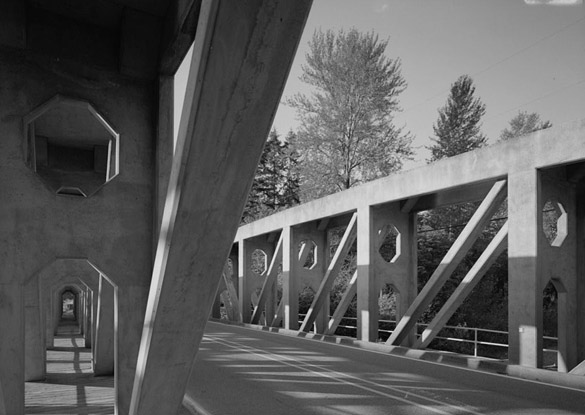Standing on the side of the road on a certain section of State Route 162 near the town of Orting, you find two sounds competing for your attention.
There is the rush of the Puyallup River — its waters, once captured in icy glaciers that cling to Mount Rainier, now flow swiftly toward Tacoma and Commencement Bay. Then there is the rumble of traffic on the two-lane road — motorcycles rev and whine, their riders enjoying an afternoon ride in the country, while cars approach the deck of the historic McMillin Bridge, laying down a heavy, rubber-meets-the-road hum.
The concrete McMillin Bridge has a long history in Pierce County. Built in 1934, it is an important section of the highway that connects Orting to Sumner. It also sits right next to an old railroad bridge that is now part of the Foothills Trail. If you’re jogging or biking on the trail, it’s hard to miss the bulky McMillin Bridge.
That could change, however, if the Washington State Department of Transportation (WSDOT) has its way. For several years now, WSDOT officials have said the old bridge is “functionally obsolete” and a new bridge needs to be built. WSDOT plans to build a new bridge just east of the McMillin Bridge and tear down the McMillin Bridge.
The proposal concerns many historic preservationists throughout Washington State and beyond. For starters, the McMillin Bridge is listed on the National Register of Historic Places. It was designed by Homer M. Hadley, a man who is famous to bridge engineers and local historians, and whose work contributed to bridges spanning rivers, lakes and creeks throughout Washington State.
Today, the future of the McMillin Bridge is uncertain.
Because the bridge is an historic landmark that crosses a waterway, WSDOT must receive permission from the U. S. Army Corps of Engineers (ACOE) before it can tear the bridge down and build a new one. So far, the ACOE hasn’t been quick to stamp its approval. Over the past two years, WSDOT has submitted three different reports arguing for the bridge’s demolition, and the ACOE has asked for more information at every turn. Meanwhile, historic preservationists, including a retired bridge engineer who spent more than 30 years working for WSDOT, have engaged a grassroots effort to save the bridge.
The McMillin Bridge has served WSDOT and millions of Pierce County drivers for 80 years. Now some people are wondering if the bridge can survive WSDOT itself.
HOMER HADLEY’S CONCRETE CONCEPTION
One could argue the McMillin Bridge probably would never have been built if not for two factors: Mother Nature and the Great Depression.
During the winter of 1933—34, Pierce County residents nervously watched as the Puyallup River swelled under heavy rainfall. As the river slowly overtook its banks and eventually flooded, a narrow, 150-foot-long steel bridge linking Sumner and Orting was nearly destroyed.
Engineers working for Pierce County and the Washington state highway department agreed a new and stronger bridge must be built, with a span long and high enough to endure the seasonal threats of Puyallup River flooding and a roadway wide enough to handle a growing interest in automobiles. At first, they put a call out for a stronger version of the steel bridge that nearly washed away. This new bridge would measure 24 feet wide from curb to curb, boast a lateral clearance of just over 25 feet, and offer 15 feet of vertical clearance. One drawback: there was no room for a pedestrian sidewalk. In August of 1934, the highway department received seven bids to build the new structure. Six of the proposals called for similar steel bridges, and ranged in cost from $36,738 to $48,250.
The seventh bid, however, was truly unusual: a bridge made of reinforced concrete that measured 22 feet wide from curb to curb, boasted a lateral clearance of 24 feet and offered an unlimited vertical clearance because it had no lateral trusses. What’s more, through what seemed like a feat of engineering magic, the concrete bridge would even have room for three-foot-wide sidewalks on each side of the roadway.
The bridge design was the work of an engineer named Homer M. Hadley, a 49-year-old structural engineer who worked for the Portland Cement Association. In the 30 years since he graduated from the University of Washington in 1905, Hadley worked as a topographical engineer in the southwest for the U. S. Geological Survey, helped build a railroad line in Alaska between the town of Cordova and a copper mine in Kennicott, designed concrete ships in Washington, D. C. during World War I, and even traveled to Japan to study the impacts of earthquakes on bridges and buildings.
By the time he submitted his proposal for the McMillin Bridge, Hadley had earned a reputation as an innovative engineer of some importance. He was president of the Western Washington chapter of the American Society of Civil Engineers. In 1928, a trade magazine named Hadley one of the “Ace Men of the Pacific Northwest.”
Still, his proposal for a reinforced concrete bridge likely left many state highway department engineers scratching their heads. For starters, he was proposing to build the longest concrete truss bridge in the country. Also, the sidewalks he envisioned didn’t run beside the arced trusses but through them instead, creating a built-in covered walkway for pedestrians. And the trusses were so thick and sturdy that there was no need for lateral bracing over the roadway. If you were to drive across the concrete McMillin Bridge, there would be nothing but open air above you. It was an incredibly simple and spare bridge. Even today, the bridge rises gracefully, not ostentatiously, from the highway, yet its concrete composition gives it a sturdy and imposing look. But perhaps the biggest selling point for the proposed bridge was the fact that it was so affordable — $35,912, just a bit cheaper than the lowest bid for a steel bridge, which was enticing to highway department officials during the cash-strapped Great Depression — and inexpensive to maintain.
Hadley’s design beat the competition. The old steel bridge damaged during the flood was moved down river and shored up so it could still be used while the new concrete bridge was constructed. Workers began to build the new McMillin Bridge in September 1934, but had to pause mid-winter when the Puyallup River flooded. By late summer, the new McMillin Bridge opened. Drivers could confidently cross the Puyallup River without fear of the bridge collapsing or washing away, and pedestrians could stop mid-span and admire the sunlight twinkling off the water and the vibrant colors of the trees bordering the river’s edge.
The McMillin Bridge was Hadley’s victory. It appeared on the cover of the January 2, 1936 edition of Engineering News-Record, a national trade magazine. The authors were impressed by how the bridge’s 170-foot span “provides the largest practical water opening for Puyallup River floods,” and raved over the “unique” idea of opening the concrete trusses to allow sidewalks to run through them.
Hadley’s interest in concrete bridges continued. He pushed for the state to build a floating concrete bridge across Lake Washington. Today, the westbound span of the Interstate 90 floating bridge is officially named the Homer M. Hadley Memorial Bridge.
Hadley died in 1967 at the age of 82. But his legacy in Pierce County is the McMillin Bridge. In 1982, Hadley was recognized for his engineering acumen when the McMillin Bridge was added to the National Register of Historic Places.
HISTORICALLY SIGNIFICANT (BUT NOT PROTECTED)
The bridge is historically significant, but that doesn’t mean it’s protected.
Placing it on the National Register of Historic Places is only an honorary designation with little regulatory bearing other than what is known as “Section 106” of the National Historic Preservation Act of 1966. In the case of the McMillin Bridge, Section 106 requires that a federal agency consult with a range of stakeholders to determine if demolishing the bridge will have any “adverse effects.” Because the McMillin Bridge crosses a body of water (the Puyallup River), the lead federal agency in this case is the ACOE. In the end, it’s the Corps that will get to decide whether to issue the permit allowing the new bridge to be built and the old bridge to come down.
In May 2010, the Corps opened up the consultation process by writing a letter to the Washington State Department of Archaeology and Historic Preservation (DAHP) recapping WSDOT’s plan. The Corps also directed WSDOT to open the discussion up to a group of nearly three-dozen stakeholders (also known as “consulting parties”) that included WSDOT, Pierce County, ACOE, DAHP, the National Trust for Historic Preservation, Washington State University, Washington Trust for Historic Preservation, bridge historians, retired bridge engineers, architectural historians, and even the Society of the Preservation of Historic Cements.
One month later, the Corps held a public meeting with many members of the consulting parties at its district office in Seattle. Minutes from that meeting reveal early arguments both for and against saving the bridge that would eventually play out over the next two years. WSDOT officials argued the bridge is “structurally deficient” and “functionally obsolete”: its roadway is so narrow and outdated, it is a hazard for trucks crossing the bridge simultaneously in both directions; and its concrete is scarred by spalling and exposed rebar.
But opponents argued the McMillin Bridge is actually in good shape and has never been saddled with load restrictions. Preservationists and retired engineers wanted inspection reports and data showing the bridge was the crumbling relic that WSDOT claimed it to be. They also stated WSDOT is more than simply a transportation agency — it is a public agency that should be equally as concerned about preservation and environmental stewardship as it is about transportation. They read directly from the transportation agency’s own environmental preservation manual: “It is WSDOT policy to avoid adverse effects, where practical, to cultural resources in planning, constructing, operating, or maintaining the state’s transportation system. These resources include prehistoric and historic archaeological sites, historic structures, and traditional cultural properties. If it is not practical to avoid adverse effects, WSDOT will minimize and mitigate effects.”
Others called out a variety of alternatives for adaptively re-using the bridge, like building the new bridge for northbound traffic and keeping the existing McMillin Bridge for southbound traffic, or re-routing the nearby Foothills Trail for bicyclists and pedestrians onto the McMillin Bridge. Other options included retrofitting the bridge to add more roadway width so it is no longer functionally obsolete, leaving the bridge in place as a ‘monument’ after the new bridge is built, and moving the McMillin Bridge to a new location.
By the end of the meeting, the Corps told WSDOT to complete what is known as a Preservation Alternatives Analysis report to suss out if any of these options were viable and to fulfill the Section 106 process required before a permit could be issued.
A VARIETY OF ALTERNATIVES
Over the next two years, WSDOT prepared three Preservation Alternatives Analysis reports. More than 200 documents over that two-year period are maintained on WSDOT’s Web site and available to the public online at ftp://ftp.wsdot.wa.gov/public/McMillin. The documents provide a comprehensive timeline of events. They are also an exhaustive, back-and-forth paper trail between WSDOT engineers, historic preservationists, the Corps, and Pierce County. But the discussion has settled on a handful of ideas first raised during the meeting two years ago with the Corps, WSDOT, and the consulting parties.
First, preservationists argue the bridge could be saved by routing northbound traffic onto the new bridge and routing southbound traffic onto the McMillin Bridge. But WSDOT countered that plan would create “an operational challenge in that it would create a divided section on a non-divided highway.” Of more concern to WSDOT, however, is the bridge’s age and condition, and the cost to rehabilitate it. WSDOT officials claim rehabilitating the bridge would cost $1.5 million, and retrofitting it for an earthquake would cost another $3 million. “The rehabilitation would repair the existing damage, but the bridge would not meet current load capacity standards,” a WSDOT official noted in one report. “Once the rehabilitation was completed, you are still left with a bridge that is over 75 years old that has experienced fatigue from earthquakes, floods, traffic, and collisions.”
Why not re-route the nearby Foothills Trail, which serves bicycles and pedestrians, off the old railroad bridge and onto the McMillin Bridge? For that to happen, WSDOT argued, Pierce County would need to take ownership of the bridge. At one point, WSDOT wrote a letter to Pierce County, asking if it had any interest in owning the McMillin Bridge. The county responded with a polite ‘thanks, but no thanks.’ “Trail users are well served by the existing bridge crossing,” wrote Pierce County Public Works and Utilities Director Brian Ziegler. “Additional trail capacity is not needed at this location . . . . The adjacent concrete highway bridge, if allowed to remain, would represent additional structural maintenance costs, uncertainty, and liability to its owner.”
Preservationists and WSDOT appear to agree that crossing the McMillin Bridge can be a hairy situation for drivers traveling in opposite directions on the very narrow bridge; drivers here complained of scrapes and broken side mirrors. For that reason, WSDOT has deemed the bridge “functionally obsolete.” Why not make it functional again by adding more roadway and wider lanes? To do so, according to WSDOT, engineers would need to make major modifications, such as “cut[ting] the bridge in half down the centerline of the road [and] mov[ing] half the bridge sideways to make room for more roadway width.” The trusses would need to be strengthened by making them larger and adding lateral bracing. “Since this option’s goal is to preserve the existing bridge due to its uniqueness, you quickly end up with a retrofitted bridge that doesn’t look anything like the original,” according to one of WSDOT’s Preservation Alternatives Analysis reports. “This option is not feasible in that you would not be able to preserve the uniqueness of the design.”
Why not leave the bridge alone as a monument to Hadley and his innovative design? Preservationists point to the Indian Timothy Bridge in Asotin County, Wash., as a previous example. In that instance, the bridge, which spanned Alpowa Creek, was left in place after a new bridge was built as part of the re-alignment of U. S. Route 12. The Indian Timothy Memorial Bridge is now part of a highway turnout and rest area. WSDOT, however, is concerned that turning the McMillin Bridge into a monument “has the potential to create additional liability for the owner with regard to graffiti, kids jumping from or climbing on the bridge, and use by fishermen since this is a ‘hot spot’ for the local angler.”
Finally, why not move the McMillin Bridge to a new location? To begin with, relocating it would involve “two of the largest cranes in the United States” to lift the 1,100-ton bridge, according to one WSDOT report. Even with the cranes, one would still have to deal with a narrow work space and staging area. “There is not enough room between the old railroad bridge upstream and the McMillin Bridge for the cranes to stage and lift the bridge and swing it onto a transport vehicle,” according to WSDOT. Another way to move the bridge would be to place a temporary bridge beneath it, jack the bridge up, and roll it away using some sort of transport vehicle. “This has the additional challenges of having to completely close the road to all traffic from the bridge site to its eventual destination along with coordinating temporary relocation of overhead utilities,” stated WSDOT officials, adding, “[D]ue to its deteriorated state, there is some question as to whether the bridge could survive the move. This option, while technically it may be feasible, is not a practical option.”
At one point, an argument was made to keep the McMillin Bridge in place as an evacuation route in case of a Lahar emergency. Pierce County had considered this idea when asked if it wanted to take ownership of the bridge. But the county felt the new bridge would be sufficient for an evacuation.
Not surprisingly, WSDOT’s Preservation Alternatives Analysis reports have repeatedly concluded the only viable alternative is to tear down the McMillin Bridge because it is both simple and relatively inexpensive: “This would require some temporary supports underneath the bridge and other protection measures to keep debris from entering the river. The estimated cost for demolition is $500,000.”
Still, with each Preservation Alternatives Analysis report WSDOT has completed, the Corps has not been satisfied that the Section 106 process has been met. Indeed, the three reports completed by WSDOT between December 2010 and July 2011 have all resulted in the ACOE asking more than 30 follow-up questions.
In one report, WSDOT argued the bridge demolition would “keep with WSDOT’s mission to keep people and business moving by operating and improving the state’s transportation system.” But ACOE project manager Sandra Manning responded, “The WSDOT mission statement does not in and of itself provide justification for demolition of the bridge and does not eliminate the need to seriously consider alternatives. The fact that WSDOT has preserved bridges in place would seem to render this justification invalid. In addition, the policy of the State of Washington encourages state agencies to protect and preserve historic structures.”
In the latest report, which was prepared in July 2011, Manning responded in part, “The Corps has reviewed this analysis and has determined that WSDOT has not provided sufficient information in the analysis to justify removal of the bridge.” Her letter included five pages of follow-up questions, such as why WSDOT protected other bridges in the past, but doesn’t see the need to protect the McMillin Bridge, and why the county should be required to assume ownership and maintenance of the McMillin Bridge in order for the bridge to be saved.
SAVE THE BRIDGE!
While WSDOT and the Corps have gone back and forth, letters have been pouring into WSDOT’s office in Olympia arguing to save the McMillin Bridge.
“I cannot stand by and ignore the act of desecration planned by WSDOT,” wrote Henry C. Matthews (no relation to this reporter), an architectural historian and professor emeritus at Washington State University who once served as a board member of the Washington Trust for Historic Preservation and was the former president of the Northern Pacific Coast Chapter of the Society of Architectural Historians. “If the McMillin Bridge is saved, it can flourish as a valued historical artifact. If it is demolished, it will be gone forever. An important piece of Pierce County history, as well as national engineering history, will be irretrievably lost. Those who choose, at great expense, to tear it apart and dispose ignominiously of the remains, will be to blame for a tragedy.”
“That the state agency, WSDOT, would want to demolish the landmark legacy of one of Washington State’s most innovative engineers is tantamount to ridiculous when a new bridge could easily bypass McMillin, leaving it to admired in perpetuity as a pedestrian and bike-way bridge commemorating one of the great civil engineering works of Washington State,” wrote Eric DeLony, Chief (emeritus) of the Historic American Engineering Record of the National Park Service.
“Demolishing this bridge will accomplish nothing noteworthy beyond the removal of an extremely rare and nationally significant bridge type of which there are less than a handful of examples nationwide, and this bridge being the largest spanning and most significant example,” wrote Nathan Holth, an author who manages the HistoricBridges.org website. “I urge you to cancel plans to demolish this nationally significant historic bridge and instead choose to preserve this lasting monument to the ingenuity of Washington State engineering.”
“I am struck by the potential for the reuse of the McMillin Bridge as well as the opportunity to do so at no significant cost,” wrote David M. Hansen, a principal at Olympia-based Outworks, a consulting firm specializing in historic preservation and military architecture. “The absence of those conditions at other locations has resulted in the steady loss of notable bridges in our state. In this instance, however, real opportunities for retention and reuse exist, and it is consistent with the direction of the Legislature in regard to historic properties to take advantage of those circumstances.”
“A bridge like the McMillin Bridge only comes around once in a lifetime,” wrote Bob George, a retired WSDOT civil and structural engineer who specialized in bridge preservation. “In my opinion, WSDOT owes it to the state’s historical heritage to find a way to save the bridge.”
While the majority of the letters support saving the bridge, the file also includes two letters arguing for the bridge’s demolition.
“While the Tribe understands that this structure is unique and one of a kind, the liability of leaving this structure in place is unacceptable for many reasons,” wrote Bill Sullivan, Director of Natural Resources for the Puyallup Tribe of Indians. “First and foremost, the Tribe is concerned that due to the age of this bridge, failure of this structure would impact fish habitat and make removal from the riverbed extremely difficult and expensive. Future liability and longterm maintenance remains unresolved and at a time when agency budgets are constrained, keeping this structure in place makes little sense. The removal of this bridge would allow for widening of the river channel and accommodating mitigation for impacts to associated wetlands from the new bridge construction. The large rock buttress supporting the old bridge could be recycled and used for the construction of the new bridge. In conclusion, the Puyallup Tribe of Indians does not support leaving the existing bridge in place.”
Pierce County executive Pat McCarthy also weighed in. “Currently, the existing concrete bridge not only shades stream habitat but it constricts floodway flows in the Puyallup River,” wrote McCarthy. “Both of these environmental constraints would be mitigated with removal of the existing bridge.” (The Corps’ response to WSDOT’s most recent Preservation Alternatives Analysis report asks for any evidence the McMillin Bridge harms fish and wildlife habitat and creates additional erosion or flooding hazards).
WASHINGTON STATE’S MONA LISA?
No one has been more vocal about saving the McMillin Bridge than retired WSDOT engineer Robert Krier. Over the past two years, Krier wrote 25 letters to WSDOT, Pierce County, the Army Corps of Engineers, the Puyallup Tribe of Indians and local media, arguing to save the bridge. It was Krier who nominated the bridge to the Washington Trust for Historic Preservation’s most endangered list last year. The Seattle-based organization created the list 20 years ago in order to bring attention to historic properties statewide that are on the precipice of being destroyed. According to Washington Trust Field Director Chris Moore, Krier brings a high level of credibility to the table because he’s a bridge engineer who spent three decades at WSDOT.
In a letter published two years ago in The Olympian, Krier passionately argued for the bridge’s preservation. “How would you feel about a public agency spending a half-million dollars to demolish the original portrait of Mona Lisa and depositing her remains in a landfill?” Krier wrote. “That is what the Washington State Department of Transportation is planning to do with the McMillin Bridge.”
Krier, 77, graduated from the University of Washington in 1956 with a Bachelor of Science degree in civil engineering, went to work for WSDOT the following year, and retired 31 years later. Today he is an engineering consultant who works out of his Olympia home, which is located near the end of a gravel road in a lushly wooded area of the city. Krier, who earned the Special Achievement Award last year from the Washington State Department of Archaeology and Historic Preservation, is relaxed and friendly, but also prepared. Over the course of a 90-minute interview in his home office — which was decorated with a large photograph of the McMillin Bridge and a retirement plaque given to him by WSDOT — he plucked photocopied reports, studies, and correspondence neatly arranged on the desk in front of him to support his answers to every question posed.
“This bridge does not have to be removed,” said Krier. “There’s no reason to tear it down. It’s in good shape. It’s in good condition.” He pointed to inspection reports completed by WSDOT in July 2009, April 2011, and June 2011 where the bridge scored a rating of ‘5’ in terms of its structural adequacy. “A condition rating of ‘5’ means it’s in fair condition, all primary structural elements are sound, but it may have minor section loss, cracking, and spalling,” he explained. “Spalling is common in concrete bridges, [as are] cracks, particularly when [the bridge] is this old. There’s no big concern. It’s minor stuff to not get too excited about. Five is a fair condition. That’s the best way to describe the condition of the bridge right now.”
Krier also challenged the notion that the McMillin Bridge was a choke-point on the Puyallup River that constricted the flow of water and impacted fish habitats. According to Krier, the McMillin Bridge has a clear opening of 163.5 feet, whereas the old railroad bridge (now part of the Foothills Trail) has a clear opening of 145.5 feet (WSDOT has agreed with these measurements, according to correspondence on its public FTP site). Moreover, county regulations require a six-foot minimum vertical clearance over the waterway. The McMillin Bridge’s minimal clearance is 7.91 feet. “The pinch point in the river is caused by the Foothills Bridge,” said Krier.
Finally, he pointed to a section of Washington state law, RCW 27.34.200, that states it is “public policy and in the public interest of the state to designate, preserve, protect, enhance, and perpetuate those structures, sites, districts, buildings, and objects which reflect outstanding elements of the state’s historic, archaeological, architectural, or cultural heritage, for the inspiration and enrichment of the citizens of the state.”
“They have the Section 106 process. They have the RCW. They have their own in-house requirements to preserve historic structures,” said Krier. “Why they are making such a resistance to [save this bridge] is beyond me. I don’t know.”
COOL. FUNKY. HISTORIC.
WSDOT appears confident that it will eventually receive a permit and move forward with the project.
In August, WSDOT project manager Steve Fuchs told me the new bridge design is nearly completed, there are some right-of-way properties to acquire, and utilities still needed to be relocated. WSDOT was “still working to obtain all the permits needed to build the project,” said Fuchs. “We are following the Section 106 process to evaluate alternatives that avoid impacting this historic structure. The Army Corps of Engineers is guiding us through the process because they will ultimately issue the permit to build the bridge.”
He added that WSDOT expected to begin construction in Spring 2014, and noted $15 million had been set aside for the project. “WSDOT does not plan to own and maintain two bridges at this location,” he said.
For Chris Moore at the Washington Trust, the fact that WSDOT has already designed a new bridge, acquired right-of-way, and planned on removing the McMillin Bridge is putting the cart before the horse. “Basically, WSDOT decided what’s going to happen before they engaged the consulting parties,” Moore told me. “They decided what’s going to happen and then worked backward through the mitigation piece. How is WSDOT allowed to come up with a conclusion [about the McMillin Bridge] and then circle back and go through the process? That’s not what consultation is. The definition of consultation is taking the plan to the stakeholders to get input before a decision is reached. But what seems to be the case is that the decision was internally reached far before consultation was initiated. That is fundamentally at issue with this bridge situation.”
Last month, Manning at the ACOE told me the most recent report it received from WSDOT was dated July 1, 2011, and the Corps responded two months later with more questions. “WSDOT is currently preparing a response to our comments on that document,” said Manning.
Retired bridge engineer Krier is pleased with the Corps’ response so far. “They are being very strong,” he commented. “They are not just bowing under to DOT’s demands. They are appreciating and recognizing the consulting parties interest in this bridge, very much so.”
Meanwhile, fuss over the humble McMillin Bridge might seem overly complex and trivial to most people. When you drive over the bridge, the experience is not grand and outsized like crossing over the Tacoma Narrows Bridges — a feeling of being lifted into the sky and over the Tacoma Narrows. Nor does it feel like you are skimming on the water’s surface like the flat and expansive stretch of Interstate 90 bridges that connect Seattle to Mercer Island.
Moore at the Washington Trust agrees that to the casual observer, the McMillin Bridge isn’t particularly outstanding. “In a lot of ways, you’ve got to like bridges to even care about it,” he said. “Bridges have a devout following. People who are lovers and followers are zealots. But when you compare bridges to grand estates and wonderful hotels, they don’t elicit the same kind of response. The way people experience a bridge is different than [the way people experience] Old City Hall in Tacoma.”
Still, even people who don’t consider themselves bridge experts can appreciate the McMillin Bridge. Moore described the bridge’s concrete trusses as “monumental” in scale, and the ability to walk through the trusses is an experience that is lost to most bridge visitors because they spend more time driving across it. “There’s almost a cathedral-like experience when you walk through those trusses,” Moore told me. “There is an architectural element to the McMillin Bridge that is missing in other bridges. It doesn’t have the ‘Erector Set’ look that steel bridges have. It has this cloistered effect when you walk under those sculptured trusses. It’s just a cool, funky historic bridge.”
To read the print edition of this article, click here.
Todd Matthews is editor of the Tacoma Daily Index and recipient of an award for Outstanding Achievement in Media from the Washington State Department of Archaeology and Historic Preservation for his work covering historic preservation in Tacoma and Pierce County. He has earned four awards from the Society of Professional Journalists, including third-place honors for his feature article about the University of Washington’s Innocence Project; first-place honors for his feature article about Seattle’s bike messengers; third-place honors for his feature interview with Prison Legal News founder Paul Wright; and second-place honors for his feature article about whistle-blowers in Washington State. His work has also appeared in All About Jazz, City Arts Tacoma, Earshot Jazz, Homeland Security Today, Jazz Steps, Journal of the San Juans, Lynnwood-Mountlake Terrace Enterprise, Prison Legal News, Rain Taxi, Real Change, Seattle Business Monthly, Seattle magazine, Tablet, Washington CEO, Washington Law & Politics, and Washington Free Press. He is a graduate of the University of Washington and holds a bachelor’s degree in communications. His journalism is collected online at wahmee.com.
For more information about Homer M. Hadley, the McMillin Bridge, and WSDOT’s project, click on the following links:
1. WSDOT’S McMillin Bridge project website
2. WSDOT’s McMillin Bridge public documents website
3. Historic American Engineering Record’s McMillin Bridge photographs and drawings
4. HistoryLink.org’s Homer M. Hadley Biography
5. Washington Trust for Historic Preservation’s “Most Endangered List”
